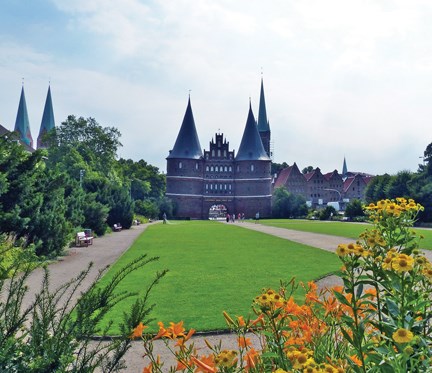Cruising aboard HAL’s Eurodam familiarizes us with a string of intriguing Baltic ports including Lubeck, a major northern German seaport founded in 1143 on the river Trave.
Guide Emma introduces old town Lubeck, “Until the end of the 16th century, Lubeck prospered as Queen of the Hanseatic League, a federation of guilds dominating northern European trade.” Only the iconic Holsten Gate remains from the 15th century wall once surrounding this island market town. Its two lofty, rounded brick towers flank a large arched entrance; a sculpted bronze map shows us the town’s early layout.
Crossing a small park to the river, we pause on a pedestrian bridge to view gabled brick warehouses built to store ‘white gold.’ Transported by wagon from Lunenburg, this precious salt preserved the codfish and herring traded throughout Europe.
Strolling in the medieval centre, we see buildings and narrow streets that retain much of their early appearance. The aristocratic homes and seven redbrick churches exemplifying Gothic architecture helped Lubeck achieve world heritage designation in 1987.
Selling local produce, handicrafts and traditional foods, vendors fill the extensive market square with bustling activity. Its town hall, one of Germany’s oldest, flaunts a mixture of styles from Gothic to Renaissance: a baroque façade, gothic arches, soaring copper spires and red-and-white Hanseatic shields. Below the Rathaus, the Ratskellar continues as a fine wine cellar, popular since 1224. More liberal than other German cities, women have enjoyed this tavern’s hospitality since 1478.
Nearby soar the twin steeples of St. Mary’s Church, built between 1250 and 1350. A symbol of prosperity, St. Mary’s is located on the island’s highest point. Inside are reminders of life’s fragility. One niche displays bells shattered during a WWII bombing. In another, a stained glass window depicts a skull. Below, one skeleton lies amid cherubic statuettes, another plays guitar. On the wall, lithographs depict the medieval Danse Macabre celebrating death, the great equalizer. At noon, an astronomical clock chimes as figures move in front of Christ, who blesses them.
Outside, a bronze devil sits grinning on a ledge. With a twinkle, Emma recaps the folklore, “Believing the townsfolk were building a tavern, the devil eagerly helped, until he realized it was actually a church! Feeling tricked, he grabbed a boulder to smash down the walls. But workmen quickly promised to build him a tavern. Pleased, the devil dropped the boulder, there beside the wall, and you’ve already seen the historic Ratskeller at our Town Hall.”
Mouth-watering slices of marzipan gateau await us at Niederegger Café. There in this classic coffeehouse, we learn Lubeck’s sweetest history. “Locals believe marzipan was first made in response to a siege or maybe famine,” Emma recounts. “Legend says the townspeople ran out of food, except for the stored almonds and sugar they used to make ‘loaves’ of marzipan ‘bread.’”
The Niedereggers have made luscious treats for 200 years. Containing less sugar than some recipes, their marzipan is known as ‘pure.’ In the downstairs confectionary, we select marzipan bonbons for our homefolks.
Continuing onward, we pause at Buddenbrooks House, former home to Heinrich and Thomas Mann, eminent German writers. Cutting through one of old town’s 82 narrow alleyways, we admire pretty homes adorned with shrubbery and flowers.
Our walk concludes at the inspiring 13th century Geist Hospital. At first caring for paupers, it evolved into one of Germany’s earliest homes for seniors. Our waiting bus soon whisks us back to the ship.



